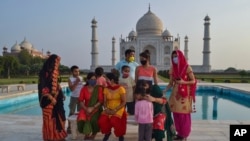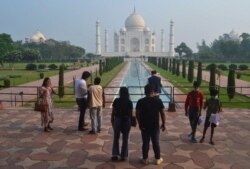India’s iconic Taj Mahal monument reopened Wednesday as a devastating second wave of the coronavirus pandemic begins to ebb, prompting authorities to ease restrictions.
A steep decline in new infections this month has encouraged major cities such as New Delhi, Mumbai and Bengaluru to reopen vast swathes of the economy, including tourist sites, hotels, shopping malls and restaurants.
But after reports came in of crowded markets and packed rail stations, doctors warned of a possible resurgence.
“It’s going to be a major risk if COVID guidelines are not followed. I am very scared we could see a third wave very early if things go on like this,” said Suranjit Chatterjee, senior consultant of internal medicine at New Delhi’s Indraprastha Apollo Hospital in New Delhi. “Citizens have to be very careful and the government has to be also very strict in enforcing restrictions.”
Restricted numbers were allowed into the Taj Mahal in Agra city, with daily numbers capped at 5,000. Before the pandemic, India’s top tourist site saw nearly 20,000 visitors daily.
Television images showed people taking selfies as they posed outside the monument that is located in Uttar Pradesh, one of the state’s worst hit by the second wave.
However, tourism industry representatives are not optimistic of a quick revival. “The situation is grim. We only expect people from cities around Agra to visit and this will not bring immediate relief because the tourist economy is largely sustained by international visitors,” said Rajiv Tiwari, president of the Federation of Travel Association of Agra. “So many tourist guides, drivers etc. are hand to mouth, and things are unlikely to return to pre-pandemic levels for two to three years.”
Tourism dependent towns like Agra are suffering for the second time since the pandemic hit. The monument had reopened in September following last year’s stringent lockdown but was shut again two months ago.
Still, it’s reopening brought a glimmer of hope to the nearly 400,000 people in the town whose livelihoods are sustained by visitors. “Some customers from Gujarat came to my shop today,” said Ramesh Chandra, owner of Marble Handicrafts, a shop selling tourist souvenirs. “I have barely done any sales in the last year, but we must look ahead.”
Agra is not the only city to reopen its doors to visitors. People also flocked to other popular tourist destinations, such as Goa and hill towns in India’s northern states to escape the sweltering heat in cities like New Delhi. Several hotel owners reported almost complete occupancy, and people shared photographs on social media of highways crammed with cars.
At its peak last month, India was reporting 400,000 cases a day. But it is reopening swiftly amid pressure to restore the millions of livelihoods that were lost during the second shutdown since the pandemic.
With less than 5% of the country fully vaccinated, though, there are fears that the more infectious Delta variant of the coronavirus that ravaged the country could again lead to a spike in infections.
Health experts say failure to follow COVID-19 protocols and super spreader events like huge public gatherings and weddings fueled India’s second wave.
“Citizens have to understand that there is a problem with this virus, it is highly contagious. If they don’t do that, we could land in big trouble again,” Dr. Chatterjee said. “We saw how the crisis hit so many families during the second wave, so we must be very cautious.”
Delhi was among the worst-hit cities as acute shortages of oxygen and hospital beds led to a public health crisis the city of 20 million had never had to endure prior.
India has reported nearly 30 million infections and 380,000 deaths, although that is widely believed to be an underestimate.












